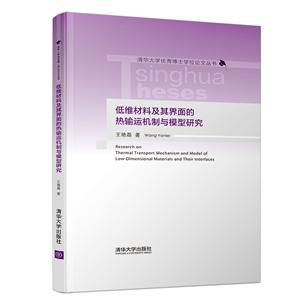-
>
湖南省志(1978-2002)?铁路志
-
>
公路车宝典(ZINN的公路车维修与保养秘籍)
-
>
晶体管电路设计(下)
-
>
基于个性化设计策略的智能交通系统关键技术
-
>
德国克虏伯与晚清火:贸易与仿制模式下的技术转移
-
>
花样百出:贵州少数民族图案填色
-
>
识木:全球220种木材图鉴
清华大学很好博士学位论文丛书低维材料及其界面的热输运机制与模型研究 版权信息
- ISBN:9787302532675
- 条形码:9787302532675 ; 978-7-302-53267-5
- 装帧:平装-胶订
- 册数:暂无
- 重量:暂无
- 所属分类:>
清华大学很好博士学位论文丛书低维材料及其界面的热输运机制与模型研究 本书特色
本书是作者在其博士学位论文的基础上总结、改进、提炼而形成的学术著作。本书通过运用大规模分子动力学模拟与理论分析相结合的方法,重点研究了石墨烯等低维材料中缺陷、无序度、弱耦合界面和强耦合界面等因素影响热输运过程的微观机制,进而基于分子动力学模拟的结果构建了适用于不同低维体系的预测热输运过程的理论模型,促进了对低维材料热输运过程的合理理解,可为微纳米电子器件热管理、新型相变传热材料设计等提供一定的科学参考依据和新思路。 本书可供微纳米材料与器件设计领域相关的学者和科研人员参考。
清华大学很好博士学位论文丛书低维材料及其界面的热输运机制与模型研究 内容简介
本书是作者在其博士学位论文的基础上总结、改进、提炼而形成的学术著作。本书通过运用大规模分子动力学模拟与理论分析相结合的方法,重点研究了石墨烯等低维材料中缺陷、无序度、弱耦合界面和强耦合界面等因素影响热输运过程的微观机制,进而基于分子动力学模拟的结果构建了适用于不同低维体系的预测热输运过程的理论模型,促进了对低维材料热输运过程的合理理解,可为微纳米电子器件热管理、新型相变传热材料设计等提供一定的科学参考依据和新思路。 本书可供微纳米材料与器件设计领域相关的学者和科研人员参考。
清华大学很好博士学位论文丛书低维材料及其界面的热输运机制与模型研究 目录
第1章绪论
1.1课题背景及研究意义
1.2研究概况
1.2.1国内外研究动态
1.2.2问题与挑战
1.3研究方法简介
1.3.1**性原理计算方法
1.3.2MD模拟
1.3.3热导率的数值计算
1.4本书的主要内容 第2章缺陷的散射机制与有效介质理论
2.1本章引论
2.2多晶石墨烯的原子结构及热导率的计算方法
2.2.1多晶石墨烯的原子结构
2.2.2热导率的计算方法
2.3多晶石墨烯热导率的计算结果
2.4多晶石墨烯的热流散射机制
2.5有效介质理论及其在多晶石墨烯中的应用
2.5.1宏观晶粒尺寸的多晶石墨烯的热导率
2.5.2多晶石墨烯热输运的温度依赖性
2.6有效介质理论在GO中的应用
2.7本章小结 第3章无序度与振动模态局域化
3.1本章引论
3.2二维双层二氧化硅的结构与计算方法
3.2.1二维双层二氧化硅的原子结构
3.2.2热导率的计算方法
3.3晶体和非晶的二维双层二氧化硅的热输运
3.4振动模态的局域化及相关的理论研究
3.4.1AllenFeldman理论
3.4.2低维材料中振动模态的局域化
3.4.3低维材料中热流的局域化
3.4.4局部无序材料的热输运模型的讨论
3.5本章小结 第4章弱耦合界面与扩散式输运模型
4.1本章引论
4.2石墨烯/铜基底界面与扩散式热输运过程
4.2.1石墨烯/铜基底界面的构建与结构优化
4.2.2石墨烯在基底上的形貌及水分子插层的影响
4.2.3水分子插层有效减弱界面的电学耦合
4.2.4扩散式热输运机制与水分子插层的影响
4.3石墨烯/细胞膜界面与扩散式热输运模型
4.3.1石墨烯/生物界面的原子结构
4.3.2石墨烯/细胞膜界面的水分子层结构
4.3.3石墨烯/细胞膜界面的热耗散过程
4.3.4扩散式热输运机制与生物纳米界面的热耗散模型
4.4关于水分子插层及扩散式输运机制的讨论
4.5本章小结 第5章强耦合分子界面的热输运研究
5.1本章引论
5.2苯环分子结界面的热输运机制与热稳定性
5.2.1苯环分子结的原子模型与界面热阻计算方法
5.2.2单分子结的热输运过程
5.2.3分子结的热耗散与热稳定性
5.2.4苯环分子结界面的热输运机制
5.3SAM/金刚石分子结界面的热输运机制
5.3.1SAM/金刚石分子结模型与界面热导的计算方法 5.3.2SAM分子结界面的热输运机制
5.3.3影响SAM分子结界面热输运性质的其他因素
5.3.4SAM作为热界面材料的应用前景
5.4强耦合分子界面的热输运机制讨论
5.5本章小结 第6章总结与展望 参考文献附录A与本书有关的物理常数及换算因子附录B振动态密度求解程序附录C振动谱能量密度求解程序附录D热导率求解程序附录E作者发表的相关文章致谢
Contents低维材料及其界面的热输运机制与模型研究
Contents
Chapter 1Introductions
1.1Background and Significance of the Research
1.2Research Situation
1.2.1Reseach Trends at Home and Abroad
1.2.2Problems and Challenges
1.3Brief Introduction of Research Methods
1.3.1FirstPrinciples Methods
1.3.2Molecular Dynamics Simulation
1.3.3Numerical Calculations of Thermal Conductivity
1.4The Main Contents of This Book Chapter 2The Scattering Mechanism of Defects and the Theory of
Effective Medium
2.1The Introduction of This Chapter
2.2The Atomic Structure of Polycrystalline Graphene and the
Method of Calculating Thermal Conductivity
2.2.1The Atomic Structure of Polycrystalline Graphene 2.2.2The Method of Calculating Thermal Conductivity 2.3The Simulated Results of Polycrystalline Graphene Thermal
Conductivity
2.4Heat Flow Scattering Mechanism of Polycrystalline Graphene 2.5Effective Medium Theory and Its Application in Polycrystalline
Graphene
2.5.1The Thermal Conductivity of Polycrystalline
Graphene with Macroscopic Grain Size
2.5.2Temperature Dependence of Heat Transport of
Polycrystalline Graphene
2.6Applications of Effective Medium Theory in Graphene Oxide 2.7Chapter Summary Chapter 3Disorder Degree and Vibration Mode Localization
3.1The Introduction of This Chapter
3.2Structure and Calculation Method of TwoDimensional
Bilayer Silica
3.2.1Atomic Structure of TwoDimensional Bilayer Silica 3.2.2The Calculation Method of Thermal Conductivity
3.3Thermal Transports of Crystalline and Amorphous
TwoDimensional Bilayer Silica
3.4Theoretical Study of Localization and Correlation of
Vibration Modes
3.4.1AllenFeldman Theory
3.4.2Localization of Vibration Modes in Low Dimensional
Materials
3.4.3Localization of Heat Flow in Low Dimensional
Materials
3.4.4Discussion on the Thermal Transport Model of
Local Disordered Materials
3.5Chapter Summary Chapter 4Weak Coupling Interfaces and Diffusional Models of Transport 4.1The Introduction of This Chapter
4.2The Interface of Graphene/Copper Substrate and the Process
of Diffusional Heat Transport
4.2.1Construction and Structure Optimization of the
Interface of Graphene/Copper Substrate
4.2.2The Morphology of Graphene on Substrate and
Effects of the Intercalation of Water Molecules
4.2.3The Intercalation of Water Molecules Effectively
Weaken the Electrical Coupling of the Interface
4.2.4Diffusional Heat Transport Mechanism and Effects
of the Intercalation of Water Molecules
4.3The Interface of Graphene/Cell Membrane and the Model of
Diffusional Heat Transport
4.3.1The Atomic Structure of the Interface of Graphene/
Biology
4.3.2The Water Molecular Layer Structure of the Interface
of Graphene/Cell Membrane
4.3.3The Heat Dissipation Process of the Interface of
Graphene/Cell Membrane
4.3.4Diffusional Heat Transport Mechanism and Heat
Dissipation Models of Biological Nano Interfaces
4.4Discussion on the Intercalation of Water Molecules and
Diffusional Heat Transport Mechanism
4.5Chapter Summary Chapter 5Study on Heat Transfer of Strongly Coupled Molecular
Interfaces
5.1The Introduction of This Chapter
5.2The Heat Transport Mechanism and the Thermal Stability
of Molecular Junction Interface of Benzene Ring
5.2.1The Atomic Model of Molecular Junction of Benzene
Ring and the Calculation Method of the Thermal
Resistance of the Interface
5.2.2The Heat Transport Process of Single Molecular
Junction
5.2.3The Heat Dissipation and Thermal Stability of
Molecular Junction
5.2.4The Heat Transport Mechanism of Molecular Junction
Interface
5.3The Heat Transport Mechanism of Molecular Junction Interface
of SAM/Diamond
5.3.1The Molecular Junction Model of SAM/Diamond
and the Calculation Method of Interface Thermal
Conductivity
5.3.2The Heat Transport Mechanism of Molecular
Junction Interface of SAM
5.3.3Other Influential Factors of the Heat Transport
Mechanism of Molecular Junction Interface of SAM 5.3.4Application Prospect of SAM as a Thermal Interface
Material
5.4Discussion on the Heat Transport Mechanism of Strongly
Coupled Molecular Interfaces
5.5Chapter Summary Chapter 6Summary and Outlook References Appendix APhysical Constants and Conversion Factors Related to
This BookAppendix BThe Solving Program for Vibrational Density of StatesAppendix CThe Solving Program for Energy Density of Vibrational
SpectrumAppendix DThe Solving Program for Thermal ConductivityArticles Related to This Book Published by the AuthorAcknowledgements
- >
山海经
山海经
¥19.7¥68.0 - >
朝闻道
朝闻道
¥8.8¥23.8 - >
企鹅口袋书系列·伟大的思想20:论自然选择(英汉双语)
企鹅口袋书系列·伟大的思想20:论自然选择(英汉双语)
¥6.3¥14.0 - >
中国人在乌苏里边疆区:历史与人类学概述
中国人在乌苏里边疆区:历史与人类学概述
¥34.1¥48.0 - >
伊索寓言-世界文学名著典藏-全译本
伊索寓言-世界文学名著典藏-全译本
¥9.3¥19.0 - >
莉莉和章鱼
莉莉和章鱼
¥13.4¥42.0 - >
小考拉的故事-套装共3册
小考拉的故事-套装共3册
¥36.7¥68.0 - >
【精装绘本】画给孩子的中国神话
【精装绘本】画给孩子的中国神话
¥19.3¥55.0
-
黑科技驱动世界的100项技术
¥21.9¥69.8 -
黑科技:驱动世界的100项技术(八品)
¥21.9¥69.8 -
指火控弹道与射击诸元理论
¥38.7¥49 -
智能照明工程手册
¥29.9¥49.8 -
光电直读光谱分析技术与应用
¥38.7¥49 -
服务型制造
¥76.3¥109





















